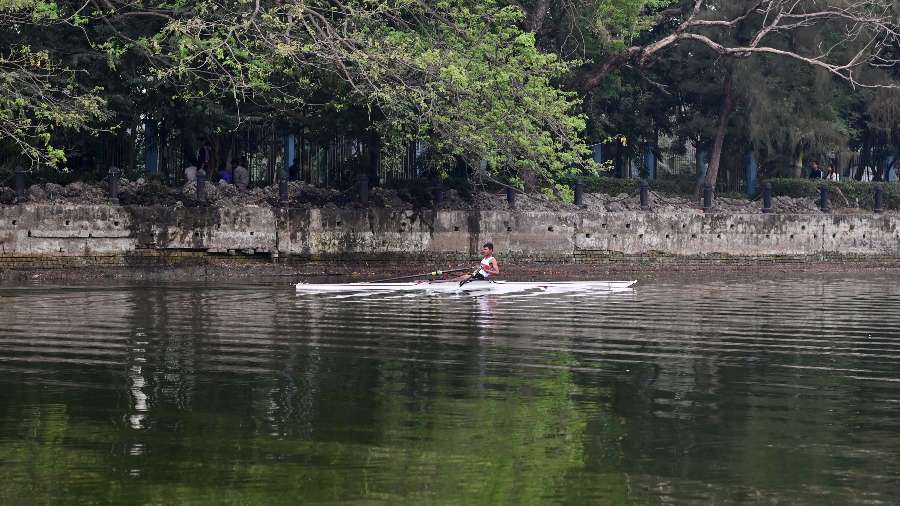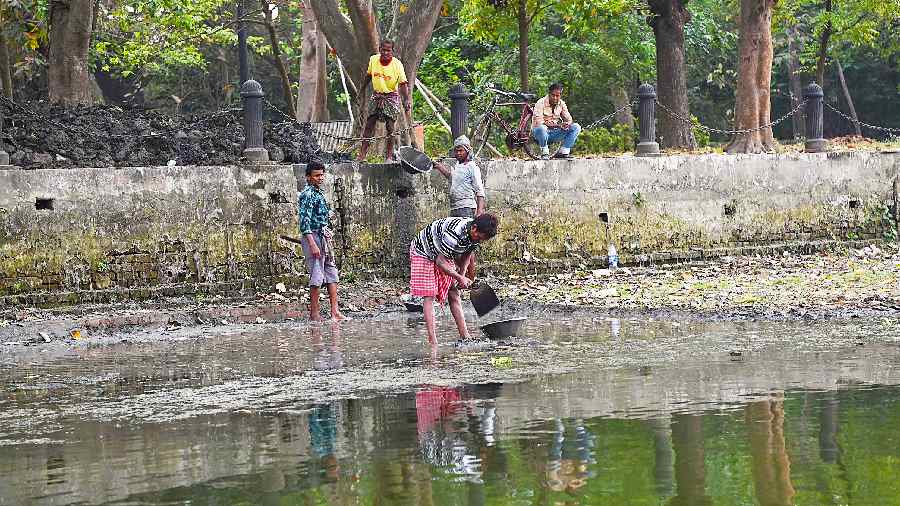The water level of Rabindra Sarobar in south Kolkata’s Dhakuria has gone down significantly, posing a challenge for rowers.
A pile of slush is visible along the banks. The boundary walls on either side bear testimony to the dwindling depth, a boat ride on Friday showed.
The fins — metallic structures fitted under the hull — of rowing boats get stuck in the slush when the oars drift towards the bank, said rowers. The oars, too, get stuck, which increases the risk for rowers and chances of damage to boats.
The Kolkata Metropolitan Development Authority (KMDA), custodian of the 192-acre water body, has started dredging the lake at multiple places.
An official of the KMDA said water loss was “normal” in the lake every year, depending on the volume of rainfall or lack of it.
But representatives of the West Bengal Rowing Association and the three clubs — Lake Club, Calcutta Rowing Club and Bengal Rowing Club — along the Sarobar said the rate of water loss was “alarming” this year.
The KMDA undertakes dredging of the lake every year.
A slice of the water body, under the Lake Gardens flyover, was barricaded with metal sheets on both sides when this newspaper visited the site on Friday.
The area in between is being dredged.

A rower on a boat near the banks of Rabindra Sarobar. Multiple boats have got stuck in the slush beneath the shallow water in the past few weeks
At a couple of other spots along the banks, towards Dhakuria, men were lifting the slush with shovels and piling it on the walkway above.
A KMDA official and club representatives attributed the water loss to a rain deficit last monsoon and a prolonged dry spell that the city has been witnessing for the past few months.
July and August, usually the rainiest months in Kolkata, had both ended with rain deficits last monsoon. The city has barely had a spell of uniform showers since late October.
A KMDA official downplayed the depleting water level. “Water loss is a yearly affair. We dredge the lake every year. This is nothing new. One or two spells of heavy rain will restore the water level,” he said.
A couple of valves are in place to drain out excess water from the lake. On Friday, the water level was much below one such valve, towards Lake Kalibari.
“The impact of rain deficit on the lake is not instant. The effect is showing now. The depleting water level might also be an indication that the overall groundwater level of south Kolkata is not in a very good shape,” said Arjan Basu Roy of Nature Mates, an NGO that is involved in multiple conservation efforts around the Sarobar.
“The depth of the water along the banks is usually around six feet. But at most places now, it is barely two feet. At multiple spots, there is no water at all and the surface is just slush,” said a vice-captain of rowing of a club.
“At least three boats got stuck in the past week. Two were damaged,” he said.
Two concrete base slabs that support the hanging bridge showed the extent of the depleting water level. A series of dark patches in the middle of the slabs suggested the usual water level, said rowers and boat keepers.
On Friday the water was at the foot of the slabs, more than three feet below the usual level.
“I have not seen such a depleted water level in 25 years,” said a member of a rowing club, a former master of the oars.
At the jetties of the rowing clubs, wooden stairs lead to the boats. Usually, half the stairs are submerged in water. But not any more.
“We had a detailed discussion with the KMDA authorities in the last review meeting. It has led to remedial measures and we hope the experts of KMDA will explore more ways to overcome the situation in anticipation of the coming summer months, where the situation is expected to get worse,” said Subhashis Mukherjee, secretary of West Bengal Rowing Association.
